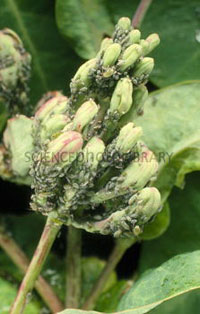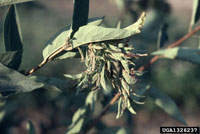Hyadaphis tataricae
Host
Honeysuckle species
Appearance and Life Cycle

Photo credit: sciencephoto.com
The honeysuckle aphid overwinters in the egg stage on the host. The eggs are light-coloured at first, later changing to a shiny, black colour. In early spring, the aphids hatch and begin feeding on newly developing honeysuckle leaves. Honeysuckle aphids are soft-bodied, pear-shaped, approximately 2 millimetres (mm) long and vary in colour from cream to pale green. The aphids produced during the growing season are all females capable of reproducing without mating, giving birth to live young. Numerous winged and wingless forms are produced throughout the spring. Host plants will be severely damaged by early summer. Aphid populations decrease significantly during the summer, possibly due to extreme heat, low moisture or maturing of the leaves. By September, with cooler temperatures, aphid populations begin to increase rapidly, causing severe damage to terminal branches. Wingless male and female adults are produced from mid-September to early October. After mating, the females deposit overwintering eggs on the host.
Damage
The honeysuckle aphid prefers to feed on the succulent new growth of the terminal leaves. Feeding stunts the growth of the leaves and causes them to fold upward along the midrib forming a pouch, enclosing the aphids. Leaves and stems change to a rosy-grey or greyish-violet colour. As feeding increases, the terminal branches droop and a "witch's broom" malformation consisting of many crooked branches and numerous, small, curled leaves develops. This infested foliage dies early in the fall and remains on the shrub as unsightly dark masses. Because the terminal branches die, severe stunting and excessive forking occurs.
Control

Photo credit: Whitney Cranshaw, Colorado State University, Bugwood.org
There is no insecticide registered for the control of the honeysuckle aphid. Some control can be achieved by pruning out and burning old, infested branches during the winter, destroying the overwintering eggs. Planting resistant varieties, cultivars other than tatarian honeysuckle, and other shrub species is also recommended.